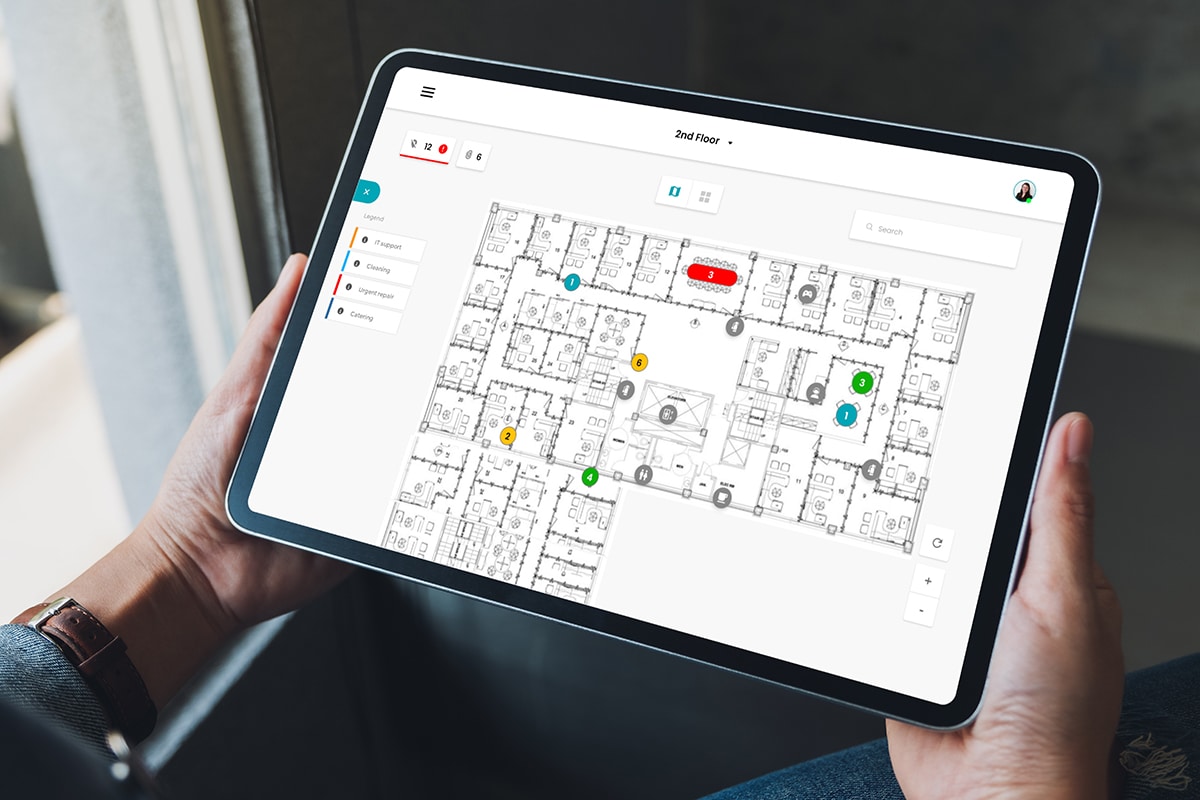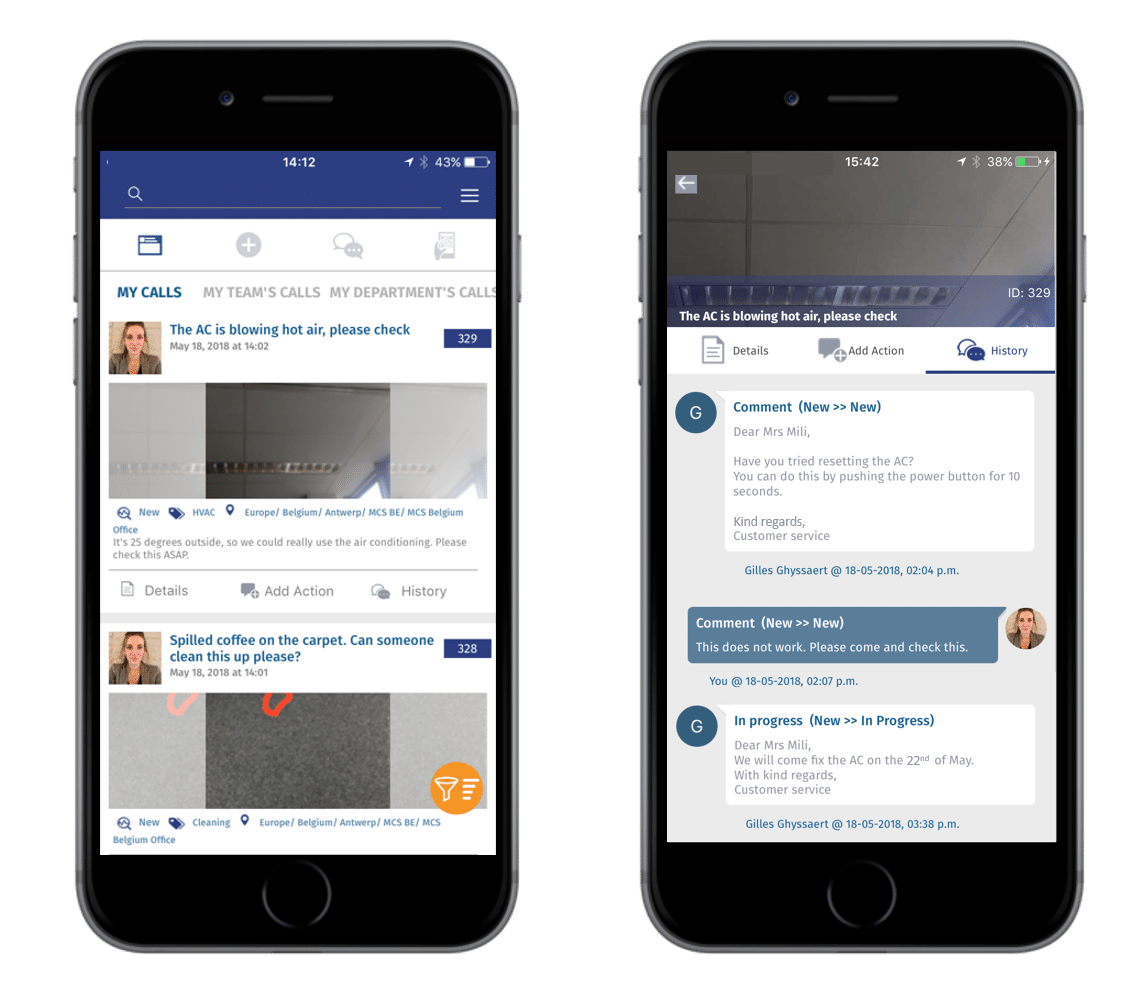The use of a mobile CMMS solution has many advantages for building maintenance. You get the benefits of a CMMS application while enjoying the flexibility and mobility of older maintenance management methods.
Despite their many qualities, traditional maintenance management software applications have a hard time seducing many companies, particularly those that deal with the maintenance of buildings where engineers and operators must remain highly mobile. This is due to their limitations in terms of user-friendliness and the fact that they cannot be used on the spot where the maintenance works is being performed. Therefore, a mobile CMMS solution is a great step forward: it meets the current challenges of modern maintenance while providing maintenance engineers with a powerful tool that is suitable and adequate for their activity.
Advantages and disadvantages of traditional CMMS solutions
CMMS solutions have made many advancements possible for companies managing maintenance activities, but they have been hindered in several areas because of the limitations they impose on maintenance engineers.
Maintenance management without a dedicated CMMS application
Before software tools became widely available, companies seeking to optimize the management of their maintenance operations used to keep track of their service visits on paper notebooks or logbooks. While this method, still used today by some companies, is always better than having no method to keep track of past maintenance activities, it is quite ineffective whenever one needs to find very specific data in the maintenance history, or to analyze historic data to optimize maintenance. Furthermore, the risk of losing information is high, as paper documents often get lost, damaged, or destroyed with time.
With the advent of Microsoft Excel, many companies began to use spreadsheets to record their maintenance visits and the tasks they performed – a method still widely used today. This reduces the risk of losing information and makes checking past maintenance operations easier. However, analyzing the maintenance history or efficiently scheduling future maintenance visits remains very difficult, complicated, or even impossible.
Suggested reading: Should you use a CMMS application or Excel to manage maintenance?
Some companies have investigated Microsoft Access as a way to manage the scheduling of routine preventive maintenance and regulatory maintenance visits on a calendar. However, when the volume of data handled reaches a certain point, the application become unresponsive due to its own limitations.
Furthermore, information sharing is always a very complex affair with such tools because they were never designed to run in a network environment.

CMMS applications – a step forward for maintenance
Software applications dedicated to maintenance management have made it possible to streamline and optimize maintenance, by providing purpose-built, customized functions. These applications offer features optimized for managing building equipment, managing spare parts inventories, and scheduling work shifts or teams according to the type of service required. They also allow preventive maintenance plans to be implemented, and safety lock-out/tag-out processes to be applied to equipment whenever a service task is about to be performed. Finally, the most efficient among such applications have features that facilitate the management of maintenance costs and offer a way to keep track of key performance indicators (KPIs).
Such CMMS applications can be expected to bring significant benefits to a company, such as:
- Greater cost control, with the monitoring of spare parts inventories (and therefore purchases) and the scheduling of service visits.
- Increased productivity, because better planning and organization of maintenance tasks ultimately results in a reduction of machine downtimes.
- Improved traceability: maintenance tasks being better documented and their history more easily accessible, maintenance management is more open and therefore tends to be better coordinated between the various parties involved.
Disadvantages of traditional CMMS applications
However, in practice, these beautiful promises are often undermined because of a few typical characteristics of such applications. Their installation is often complex, and they tend to be difficult to use. They require a complicated configuration process and impose a long period of training for maintenance teams. Maintenance engineers are often reluctant to use them because these tools often lack the sort of user-friendliness or user experience efficiency they expect to find, such as can typically be found on modern popular applications for daily life. Even more importantly, these solutions are not mobile, which means they cannot be used wherever maintenance tasks are performed, leading to multiple time-consuming data entry operations.
As a result, maintenance engineers generally prefer to avoid getting involved in the implementation of such tools, using them reluctantly and perceiving them as an additional burden to their workload. This lack of involvement has very clear consequences in terms of maintenance management: the information entered in the system is often incomplete or inaccurate, which leads to previously used methods tending to persist, which in turn, to a large degree, cancels out the benefits that could be expected from the implementation of a CMMS application.
There are many examples of companies that wanted to adopt a CMMS application but found themselves having major difficulties implementing it, with maintenance teams unable or unwilling to adopt the new tool. The effort to answer these pitfalls has been the reason why new editors have developed mobile CMMS applications.

Mobile CMMS – a small revolution
Choosing a mobile CMMS application will make maintenance teams much more willing to take advantage of the full potential of a CMMS.
How does a mobile CMMS work?
In practice, a mobile CMMS is based around a CMMS application that runs on tablets or smartphones. Some of these solutions look very similar to popular everyday apps available on both Android and iOS.
More precisely, CMMS application publishers generally offer two versions of their solution, both requiring an Internet connection. The main application, being the more complete of the two, is a desktop application running in a web browser, therefore requiring a computer. The mobile application, designed for Android or iOS, is a CMMS application that offers a subset of the features available on the desktop application. Naturally, both applications share the same data.
Advantages of a mobile CMMS application
Obviously, the main advantage of a mobile CMMS is – you guessed it – its mobility. This is a major asset, particularly where the application is mostly used for building maintenance. Indeed, maintenance engineers who use a mobile CMMS application can write up and send their reports immediately after concluding their maintenance work, which saves them from having to first write it down in a notebook before leaving for the office where they will have to enter the same information on a computer or having to memorize the information before leaving – a practice that often leads to loss of information. Engineers can also use it to access any information they might need for a job, such as the technical data sheet of a particular piece of equipment or any safety instructions to be followed.
In other words, a mobile CMMS will allow you to follow in real time the state of your real estate assets, with each service visit acting as a validation or upkeep of the collection of objects and elements that make up the building. From that point forward, thanks to your mobile CMMS application, your engineers will be entering their data on the system every day, and the complete set of information you hold on your real estate assets will be regularly updated. The maintenance manager, having reliable and relevant information at his fingertips, will easily be able to anticipate future maintenance requirements (predictive maintenance).
In most cases, implementing a mobile CMMS application to manage maintenance will make your engineers happy, not only because such an application is more user-friendly than a traditional CMMS application, but also because it will simplify their administrative tasks (reports, analysis, documentation, etc.).
Finally, a mobile CMMS opens the door to the use of QR codes and NFC chips, allowing equipment to be scanned and identified very quickly with the help of the application. This saves valuable time to operators and avoids costly mistakes resulting from confusions between similar pieces of equipment.
Although the difference between a traditional CMMS and a mobile CMMS may seem unimportant at first glance, consisting only of being able to use the software on tablets or smartphones, the advantages of a mobile CMMS have numerous practical ramifications, direct and indirect, which add up to helping the maintenance personnel support the application, improving the overall maintenance management and increasing productivity for the company tasked with maintaining the buildings and their equipment.









